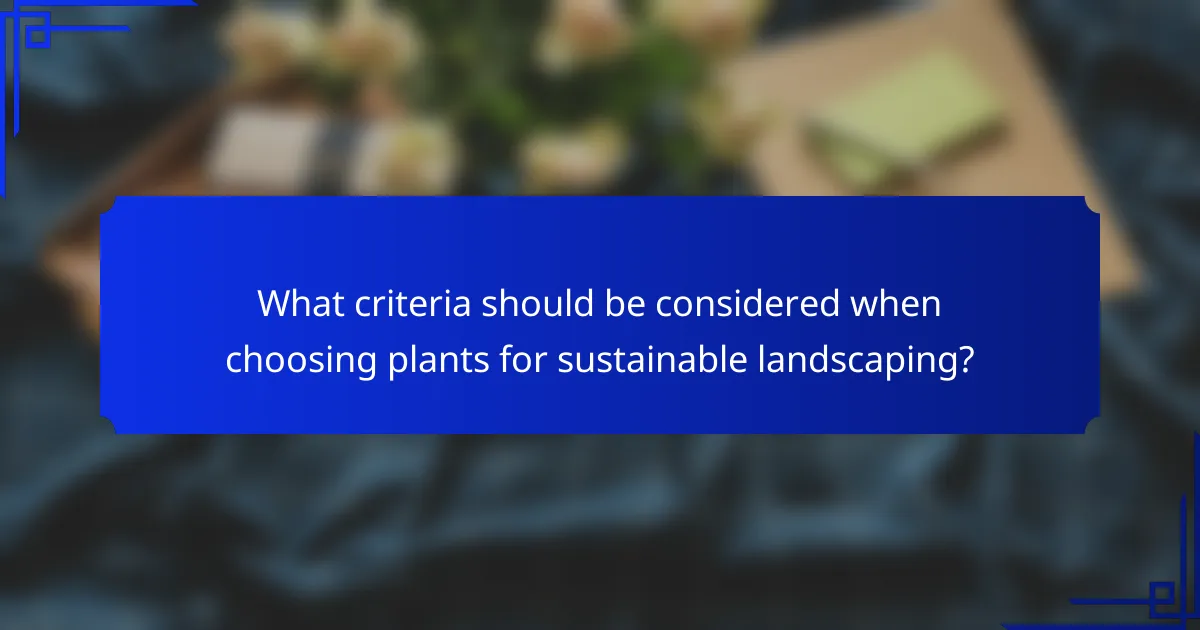Sustainable landscaping practices, such as using native plants, xeriscaping, and rain gardens, play a crucial role in promoting environmental health and resource conservation. By selecting plants that thrive in local conditions, reducing water usage, and managing stormwater effectively, these methods create beautiful and resilient outdoor spaces that benefit both people and ecosystems.

How can native plants enhance sustainable landscaping in California?
Native plants significantly enhance sustainable landscaping in California by promoting biodiversity, reducing resource consumption, and creating resilient ecosystems. These plants are adapted to the local climate and soil conditions, making them easier to maintain and more beneficial for the environment.
Low maintenance requirements
Native plants typically require less maintenance compared to non-native species. They are well-suited to California’s climate, meaning they often need minimal watering and are more resistant to local pests and diseases. This can lead to reduced labor and lower costs for homeowners and landscapers alike.
Choosing native species can simplify landscaping tasks such as pruning and fertilizing. Many native plants thrive on natural rainfall, which can save time and resources in garden upkeep.
Support local wildlife
Integrating native plants into landscaping supports local wildlife by providing essential habitats and food sources. Birds, butterflies, and beneficial insects are more likely to thrive in environments that feature native flora, which has co-evolved with these species over time.
For example, planting California poppies or manzanita can attract pollinators, while oak trees can provide shelter and food for various bird species. This creates a balanced ecosystem that enhances biodiversity in urban and suburban areas.
Water conservation benefits
Native plants contribute to water conservation by requiring less irrigation than non-native varieties. Many native species are drought-tolerant, making them ideal for California’s dry summers and variable rainfall patterns. This not only conserves water but also reduces the need for irrigation infrastructure.
Incorporating native plants into landscaping can significantly lower water bills and help homeowners comply with local water conservation regulations. By selecting drought-resistant species, you can create a beautiful landscape that thrives with minimal water input.

What is xeriscaping and how can it be implemented in Arizona?
Xeriscaping is a landscaping method designed to reduce water use by incorporating drought-resistant plants and efficient irrigation techniques. In Arizona, where water scarcity is a concern, implementing xeriscaping can significantly lower water consumption while creating a visually appealing landscape.
Design principles for xeriscaping
The design principles of xeriscaping focus on maximizing water efficiency and minimizing maintenance. Key strategies include grouping plants with similar water needs, using mulch to retain moisture, and designing landscapes that capture and direct rainwater. Additionally, incorporating hardscapes such as rocks and gravel can reduce the area needing irrigation.
When planning your xeriscape, consider the natural contours of your property. This can help in directing water flow and reducing erosion, enhancing the overall sustainability of your landscape.
Plants suitable for xeriscaping
Choosing the right plants is crucial for successful xeriscaping in Arizona. Native plants such as desert marigold, agave, and red yucca thrive in arid conditions and require minimal watering. These plants not only conserve water but also support local wildlife.
In addition to native species, consider drought-tolerant varieties like lavender and rosemary. These plants can add color and fragrance while still being efficient in water usage. Aim for a mix of perennials and shrubs to create a diverse and resilient landscape.
Cost savings on water bills
Implementing xeriscaping can lead to significant cost savings on water bills, especially in regions like Arizona where water rates can be high. Homeowners may see reductions of up to 50% in water usage after transitioning to a xeriscape design.
In addition to lower water costs, xeriscaping can increase property value by enhancing curb appeal and reducing maintenance needs. Over time, the initial investment in drought-resistant plants and efficient irrigation systems can pay off through lower utility bills and increased home equity.

How do rain gardens improve stormwater management in urban areas?
Rain gardens enhance stormwater management in urban areas by capturing and absorbing runoff from impervious surfaces like roads and rooftops. They reduce flooding, recharge groundwater, and filter pollutants, making them an effective solution for urban water management challenges.
Reduction of runoff
Rain gardens significantly reduce runoff by allowing rainwater to infiltrate the soil instead of flowing into storm drains. By incorporating native plants and soil amendments, these gardens can absorb a substantial amount of rainfall, which helps mitigate flooding during heavy storms.
In urban settings, where impervious surfaces dominate, rain gardens can capture and manage tens of thousands of liters of water annually. This not only decreases the burden on drainage systems but also lessens the risk of erosion and sedimentation in local waterways.
Enhancement of local biodiversity
Rain gardens promote local biodiversity by providing habitats for various species, including pollinators, birds, and beneficial insects. By using native plants, these gardens attract wildlife that is adapted to the local ecosystem, fostering a balanced environment.
Incorporating a diverse range of plants in rain gardens can support different life stages of insects and provide food sources for birds. This biodiversity contributes to healthier ecosystems and can enhance the aesthetic appeal of urban landscapes.
Improvement of water quality
Rain gardens improve water quality by filtering pollutants from stormwater before it reaches local waterways. As water percolates through the soil and plant roots, contaminants such as heavy metals, nutrients, and sediments are naturally removed.
Studies show that well-designed rain gardens can reduce pollutants by significant percentages, making them a vital tool for urban areas facing water quality issues. Regular maintenance, such as removing debris and ensuring proper plant health, is essential to maintain their effectiveness over time.

What are the benefits of composting for sustainable landscaping?
Composting offers numerous benefits for sustainable landscaping, including enhanced soil quality, reduced waste, and cost savings. By recycling organic materials, composting enriches the soil and supports healthy plant growth while minimizing environmental impact.
Soil health improvement
Composting significantly improves soil health by increasing its organic matter content. This organic matter enhances soil structure, promotes better water retention, and fosters beneficial microbial activity. Healthy soil leads to stronger plants that are more resilient to pests and diseases.
Incorporating compost into your landscaping can boost nutrient availability, allowing plants to thrive. Aim to mix compost into garden beds at a ratio of about one part compost to three parts soil for optimal results.
Reduction of landfill waste
Composting helps reduce landfill waste by diverting organic materials from trash. In many regions, food scraps and yard waste make up a significant portion of landfill content. By composting these materials, you contribute to waste reduction efforts and lower greenhouse gas emissions.
Consider setting up a compost bin or pile in your backyard to manage kitchen scraps and garden waste effectively. Many municipalities also offer composting programs that can assist in this effort, making it easier to participate in sustainable practices.
Cost-effective soil amendment
Using compost as a soil amendment is a cost-effective way to enhance your landscaping. Instead of purchasing commercial fertilizers, you can create nutrient-rich compost at home, reducing your overall gardening expenses. This practice not only saves money but also promotes environmental sustainability.
To maximize savings, consider composting kitchen scraps, yard waste, and even cardboard. Over time, this can significantly lower your gardening costs while improving soil quality and plant health.

What criteria should be considered when choosing plants for sustainable landscaping?
When selecting plants for sustainable landscaping, consider factors such as climate adaptability, soil compatibility, and water needs. These criteria ensure that plants thrive in their environment while minimizing resource use and maintenance efforts.
Climate adaptability
Climate adaptability refers to a plant’s ability to thrive in specific weather conditions, including temperature ranges and precipitation patterns. Choosing native plants that are well-suited to your local climate can significantly reduce water and maintenance needs.
For example, in regions with hot summers and cold winters, select perennials that can withstand temperature fluctuations. Research local plant hardiness zones to identify suitable species that will flourish in your area.
Soil compatibility
Soil compatibility involves understanding the soil type and its nutrient content to ensure plants can establish healthy root systems. Different plants have varying preferences for soil pH, drainage, and texture, which can affect their growth and sustainability.
Before planting, conduct a soil test to determine its characteristics. For instance, sandy soils may require drought-tolerant plants, while clay soils might support moisture-loving species. Adjusting soil conditions through organic amendments can also enhance compatibility.
